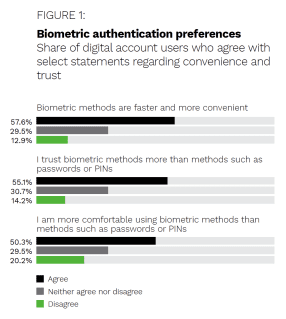PYMNTS Intelligence: How Biometrics, 2FA Can Help Game Developers Win The Digital Identity Game

The digital gaming industry was valued at $300 billion globally last April, with more than 500 million new players logging on over three years. Game publishers and developers now realize that they have key opportunities to capture the lasting loyalty of millions of new customers. To do so, however, they must be sure they can lock out the fraudsters who have flocked to the industry alongside legitimate gamers.
Large-scale data breaches are becoming more numerous within the industry. Japanese video game developer Capcom recently acknowledged a data leak that occurred at the beginning of 2021 that compromised the information of more than 390,000 customers or business partners, leaving email addresses, passwords and payment details exposed. Failing to ward against such attacks could damage video game developers’ revenue streams as well as their relationships with online gamers.
Harnessing digital identity verification to protect against cyberattacks and fraud is a critical task for gaming companies wishing to seize upon the industry’s ballooning popularity and value. This month, PYMNTS examines the importance of robust digital identity and authentication solutions in online gaming. We also examine why gaming developers and publishers must take swift steps to ensure they can distinguish between legitimate consumers and fraudsters as the industry expands.
Keeping Fraudsters From Getting Into the Game
Consumers are sharing an ever-increasing amount of data online, presenting challenges for game developers seeking to protect their platforms from fraud. Research shows that individuals are growing more and more comfortable placing large amounts of their personal information online in one place. PYMNTS’ February 2022 ConnectedEconomy™ report, for example, found that 33% of consumers would consider sharing data about their entertainment preferences to a central digital location. Many consumers also still rely on legacy security methods, such as passwords and usernames, to log in to their online accounts. Their password hygiene also often leaves much to be desired, with one study finding that only 35% of consumers create unique passwords for each account they open online. This leaves a significant number protecting everything from their bank accounts to their retail or video gaming subscriptions with identical credentials.
Such behaviors could put any online account in fraudsters’ crosshairs. Still, consumers’ growing use of in-game currencies and microtransactions has made digital gaming a particularly enticing target for today’s cybercriminals. Players can leverage games’ internal currencies to access exclusive features or content that can improve their gameplay, with fiat currency being used to purchase either in-game currency or features. The number of consumers willing to pay to access in-game currency is on the rise, with one study finding that money spent on video games rose 33% at the start of the pandemic, when digital gaming interest boomed — and fraudsters were not oblivious to this spike in interest.

Online gaming suffered the greatest share of successful cyberattack attempts out of all digital sectors in 2020, with 33% of such attacks proving successful. Enabling secure gaming transactions thus requires platforms to be able to easily distinguish between legitimate players and fraudsters armed with stolen credentials. This makes innovative, robust identity authentication not just important but imperative.
Winning the Digital Identity Game
Implementing solutions such as biometrics or two-factor authentication (2FA), which do not rely on static passwords, is one-way developers could meet these shifting security needs. Putting identity verification solutions in place that allow gaming platforms to set aside passwords and usernames, which are too easily guessed or stolen, enables publishers to better verify and authenticate legitimate customers’ identities at speed without compromising the gaming experience.
Doing so also could help game publishers retain the engagement and loyalty of digital gamers who also have become more attuned to online fraud. One recent report found that 20% of digital gamers in the United Kingdom have been victimized by fraud or are aware of other players who have been targeted, for example. The study also found that 32% of those surveyed cited security concerns when playing on their computers, mobile phones or other gaming consoles, indicating that more robust security measures likely would be of high value. Recent PYMNTS data revealed that 58% of digital account holders already consider biometrics more convenient, while 55% trust the technology more than they do passwords or PINs.
Gaming platforms should prioritize the implementation of biometrics, 2FA and other next-generation authentication tools as they work to secure their platforms and keep gamers satisfied. Keeping pace with shifting identity verification developments will help lock out fraudsters who are constantly devising new ways to infiltrate their platforms.
